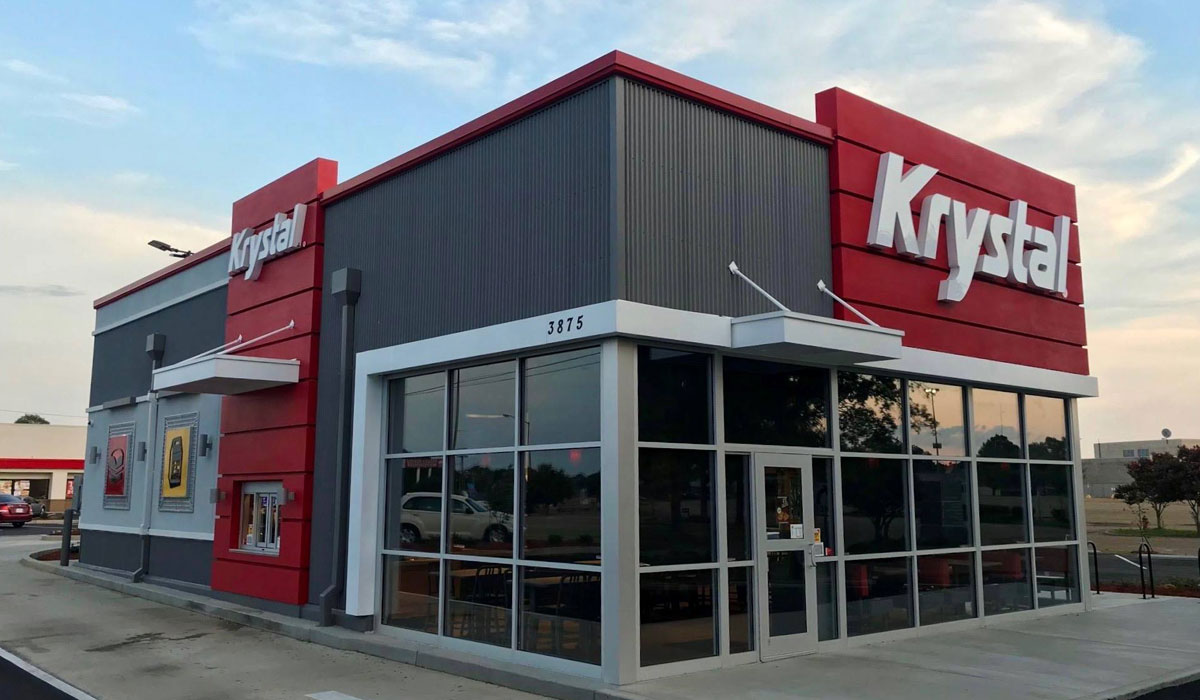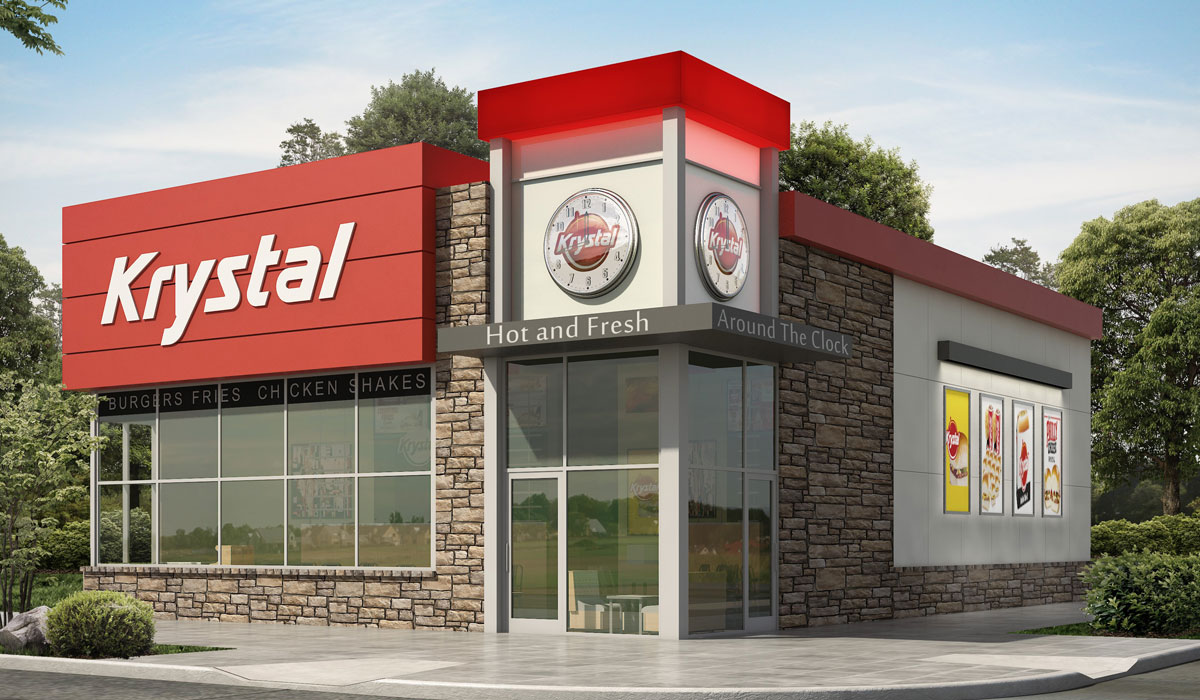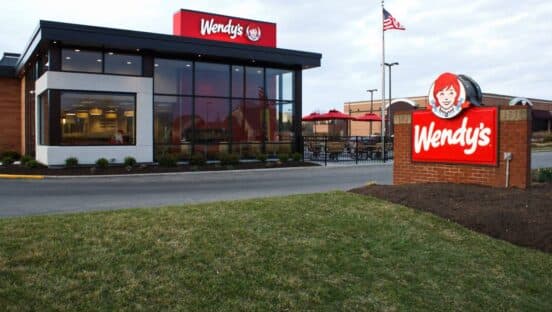If you were going to capture the issues facing CEO Paul Macaluso and Krystal into one, neat package, it might look something like this. Over the past year, the legacy burger chain, founded in 1932 on a downtown street corner in Chattanooga, Tennessee, expanded its third-party delivery presence from 2 percent to more than 60 percent systemwide. In some locations, the switch flipped but the power didn’t. Krystal was left wondering why a particular restaurant wasn’t getting orders? Why were the ratings so low?
The reason: Customers were placing orders, but the restaurant simply wasn’t receiving them. “As you can imagine that’s a frustrating situation for everybody,” says Macaluso, who joined Krystal from McAlister’s Deli last April, “because there’s sales to be had. Business to be had. And customers didn’t understand what was going on.”
What was the problem? Some 40 percent of Krystal’s restaurants are more than 40 years old. And it isn’t always easy, and very seldom reliable, to ensure good reception on tablets. That’s one of those “sounds simple, but is really anything but” details that might not garner sexy headlines, yet illustrates exactly what’s transpiring in an 86-year-old company staging a comeback.
Krystal didn’t have the tools or infrastructure to capitalize on its brand differentiators, Macaluso says. In this case, pent-up delivery demand, especially late night, didn’t stand a fighting chance.
While this painted a challenging task for Macaluso, it also represented an opportunity he couldn’t pass up when the position opened following Omar Janjua’s jump to Taco Bueno. The former McAlister’s president led marketing at FOCUS Brands’ entire portfolio before focusing on the sandwich chain. So he brought creative energy and promise to Krystal from day one, especially where it involves messaging and trying to reinvigorate a static brand.
But what about the more nuts-and-bolts changes? Some fixes over the past year have produced results, Macaluso says, unlike anything he’s seen in 25-plus years of restaurant experience.
And it all leads back to the delivery example. What Krystal was doing, Macaluso says, was getting in its own way.


Let’s start with late-night business. Krystal has enjoyed a rampant fanbase in this segment for decades. In 2018, delivery sales soared for Krystal’s sweetest daypart. Roughly 50 percent of third-party delivery business occurred after 10 p.m., and 75 percent took place post-4 p.m. In both cases, average check increased significantly. Guests ordering large orders via delivery? Far more frequent than walking in and waiting at 2 a.m.
Delivery is a leading reason late-night sales boomed 8 percent last year, Macaluso says. The chain even had a late-night themed ad that generated north of 1.2 million page views. Krystal saw the demand and it did something about it.
“We started playing to our strengths in terms of how we marketed that business,” Macaluso said. “How we also designed the menu.”
Krystal presented more of its larger packs, what it calls “multiples.” Options that allow for quick and easy purchase of sackfulls and steamer packs—options likely to be picked by late-night guests.
As the sales volume flooded in, Krystal staffed up. Macaluso says some locations doubled their sales after 10 p.m. and simply needed more employees. A good problem to have, although it wasn’t always easy to satisfy. Finding employees who work late into the morning aren’t as painless to find, but Krystal’s small-market strategy eased the task somewhat (more on this shortly).
Krystal also expanded the hours of operation in certain markets. It took some stores 24/7 that weren’t before. Others went what Krystal calls “24/2,” which means they’re open 24 hours on Friday and Saturdays.
Krystal plans to add an additional 60 restaurants into its delivery base in 2019. The economics make sense. Macaluso says they’ve found the business “very incremental,” and, of its five dayparts, late-night was the top performer, in terms of year-over-year growth, in 2018. “We definitely know that’s something we’ve got to put more emphasis behind it in 2019,” he says.
“We’ve probably lost customers in the last decade faster than other brands because we haven’t been as good at updating our facilities. When we do, people really flock back.” — Paul Macaluso, Krystal CEO.
As for the experience, Macaluso says, it’s “been a journey.” Krystal works with four main providers, UberEats being the biggest (the other three are Grubhub, Waitr, and DoorDash).
“We’ve learned what their strengths are,” he says. “We’ve taken successes form one partner and used it in another when it comes to different marketing promotions. We’ve done everything from a free delivery promotion to try to spike sales to pay for incremental placement or premium placement on their platforms to understand that pays for itself.”
Returning to the initial anecdote—Krystal’s WiFi issues—Macaluso says the brand added backup cell service for tablets and made sure it optimized each restaurant’s network. It also worked with some of the aggregators to understand what works best and if there were specific tablets more compatible with Krystal’s cell service.
“There’s a lot to it,” Macaluso says. “We have a whole team dedicated to it now. When we first started it was just part of someone’s job in the marketing department. Part of someone’s job in the operations department.”
And, not to be glossed over, marketing played a significant role. “You know, there are lots of people who thought of us for late night. But some people may have forgotten about us,” Macaluso says.
Krystal had to remind people, he adds. “And we had to make sure we were reaching people in the right venue when they’re thinking about grabbing something to eat late at night.” The chain optimized media in terms of pushing a lot more digital, social, as it targeted the right customer. What Krystal did, essentially, was something many brands in all sectors of customer service whiff on. It met consumers where they were already. Instead of trying to change behavior, Krystal just provided guests access to buy what they want.

Scrape and thrive
Here’s where Macaluso was really caught off guard. Given Krystal’s age, a new prototype was in order. But the results have been eye-popping empathic so far. In the brand’s razed and redesigned stores, or “scrapes and rebuilds,” restaurants are generating sustained sales-volume lifts of 70–80 percent. Like delivery, the improved business is leading to more staff. Macaluso says Krystal sees average staffing increases of 66 percent in fresh designs. Staffing is up from 30 to 50 employees at each of the five prototypes. Krystal plans to redesign 75–100 restaurants over the next five years, representing about 40 percent of its corporate portfolio.
What Macaluso found so interesting from 2018’s results were that “new” restaurants hadn’t moved. They had the same menu. Sometimes Krystal turned the building, like its Tifton, Georgia store. When that unit was built 45 years ago, it faced the main road. Today, it was a side street. So Krystal flipped it 90 degrees to make it more visible. In some other cases, Krystal moved the restaurant closer to the road so cars could see it easier. But by and large, these are the same properties offering the same product.
“This speaks to the fact we have a much older asset base,” Macaluso says. “We’ve probably lost customers in the last decade faster than other brands because we haven’t been as good at updating our facilities. When we do, people really flock back.”
At an Elvis Presley Boulevard location in Memphis, built 51 years ago, Macaluso was blown away by the local response after remodel. “We’re getting more than I’ve seen in my career, people coming back to our buildings,” he says. “That’s what’s leading to our sales increase. And we’ve optimized operations so we can handle more people.”
Beyond updated kitchens and facility layouts, the new designs are built operationally to capture other trends in Krystal’s changing business.
Fifty years ago, Macaluso says, Krystal’s business was probably 70 percent dine-in and 30 percent drive thru. That dynamic has flipped. The new stores optimize the experience with two lanes that funnel into one. There are two speaker boxes and menuboards so the staff can take multiple orders at once. There are also optimized work areas inside that enable Krystal to quickly fulfill drive-thru orders without extra steps.
Krystal upgraded point-of-sale monitors to help employees keep track of added orders. Want proof it’s working: Speed of service dropped more than 20 seconds in 2018, which is a huge change, especially at peak hours, Macaluso says.
For perspective, according to this year’s QSR Drive-Thru Study, average speed-of-service times—the time between the customer placing his or her order and then receiving it—largely slowed across the board among the major players. This year’s brands clocked in at an average of 234 seconds, compared with about 225 seconds last year. Back in 2003, the year Wendy’s scored an all-time Drive-Thru Study best of 116 seconds, the national average was about 190 seconds

The general consensus is that, industry wide, as traffic in the drive thru increases, times slow down. But Krystal was able to quicken the pace with extra volumes in the new restaurants, Macaluso says.
And just the look and feel of the new design is making a big difference, he adds. Full floor-to-ceiling windows. An open and inviting setting. Community tables. “On the inside, we’re also seeing a lot more business because people feel good about being there. It’s a nice, inviting place,” Macaluso says.
Krystal has even had to add double grills and expand the work area about 2 feet in some recent remodels to handle heightened business.
The design helped with hiring, too. Macaluso says there’s a definite correlation between having a stodgy run-down restaurant and high turnover. On the flip side, employees are happier when they work somewhere that doesn’t look like it needs to be cleaned for eight straight hours.
When Macaluso joined Krystal, the chain was pushing 220 percent turnover rates. In his first nine months, the number dipped below 200 percent, Macaluso says.
He credits the change to improved recruiting. And also to keeping management and core crews in place with scrape and rebuilds. After that four-month process, Krystal can tap into recruiting for a “brand-new shiny building,” Macaluso says.
“People will have their family and friends come in and see them working there and it looks really nice,” he adds. “That’s been an eye opener for all of us as well. It hasn’t been hard to recruit to these new restaurants.”
Krystal, typically, also spreads its restaurant base into smaller markets. This means it becomes an employer of choice from the outset. And with the added volumes, Macaluso says, there’s been no shortage of hours to go around, and “it feels really good to go into these communities and make an impact by helping employ more people,” he says. “It’s been one of the best parts of this job in the first year.”
A key development to watch is Krystal’s franchise system. The brand just started franchising in the 1990s, so many of those operators are running newer stores than the corporate base. But, as the results suggest, they’re excited about the new builds and are eager to remodel, if not scrape and rebuild. About a dozen stores are lined up for a refresh in 2019 to capitalize on some of the biggest features.

And, “one of the most exciting parts,” Macaluso says, is that Krystal is starting to look at adding new franchises—something it hasn’t done in many years. The brand is currently about 25 percent franchised—a far cry from the franchise dominant FOCUS Brands model.
When Macaluso came on board with Krystal, the 364-unit brand’s sales dropped more than 6 percent in the previous two years. He said Krystal wouldn’t look to grow until it boosted the top and bottom line.
This new model, and the results it’s generating, accelerates the conversation.
“We’re starting to recruit for new franchisees to come into Krystal and build this prototype,” Macaluso says. “So it would be someone coming into a new market to build this new build that we know will do tremendous volume. That’s super exciting. We’re going to start that process here the next quarter.”
Macaluso says Krystal would likely start opening fresh franchises in 2020, which is right on track with his early goals.
Additionally, Krystal is working on online ordering this year. Everything to date has been third party. But seeing how well it’s done, Macaluso says, the brand saw reason to invest in its own online-ordering platform. Currently, Krystal just has an email club where guests can sign up and receive text or email updates. But you can’t order. “We think that will continue to grow what we know is something that consumers really want from us,” Macaluso says. “And I’m excited to get that going as another point of expanding accessibility to the brand.”







